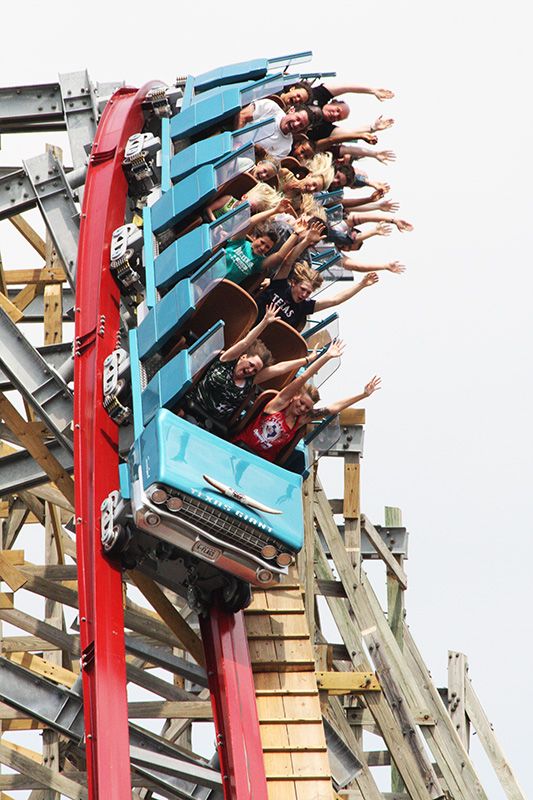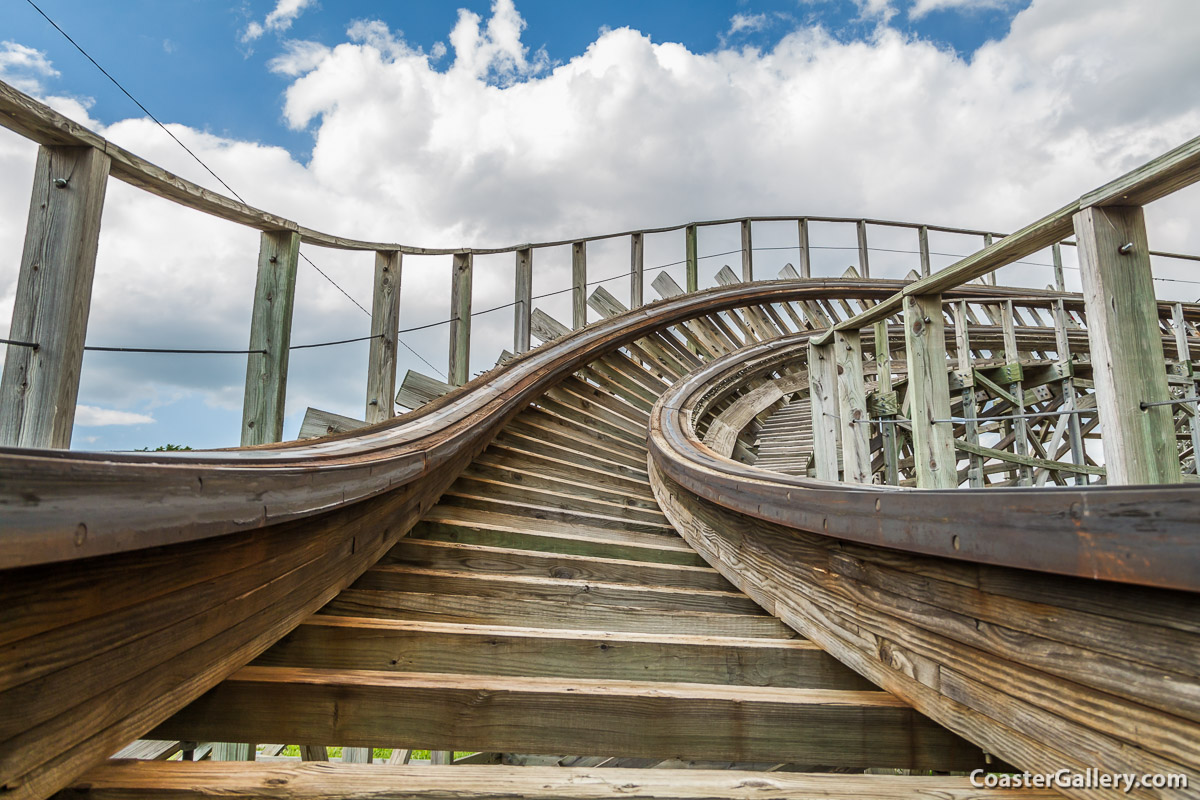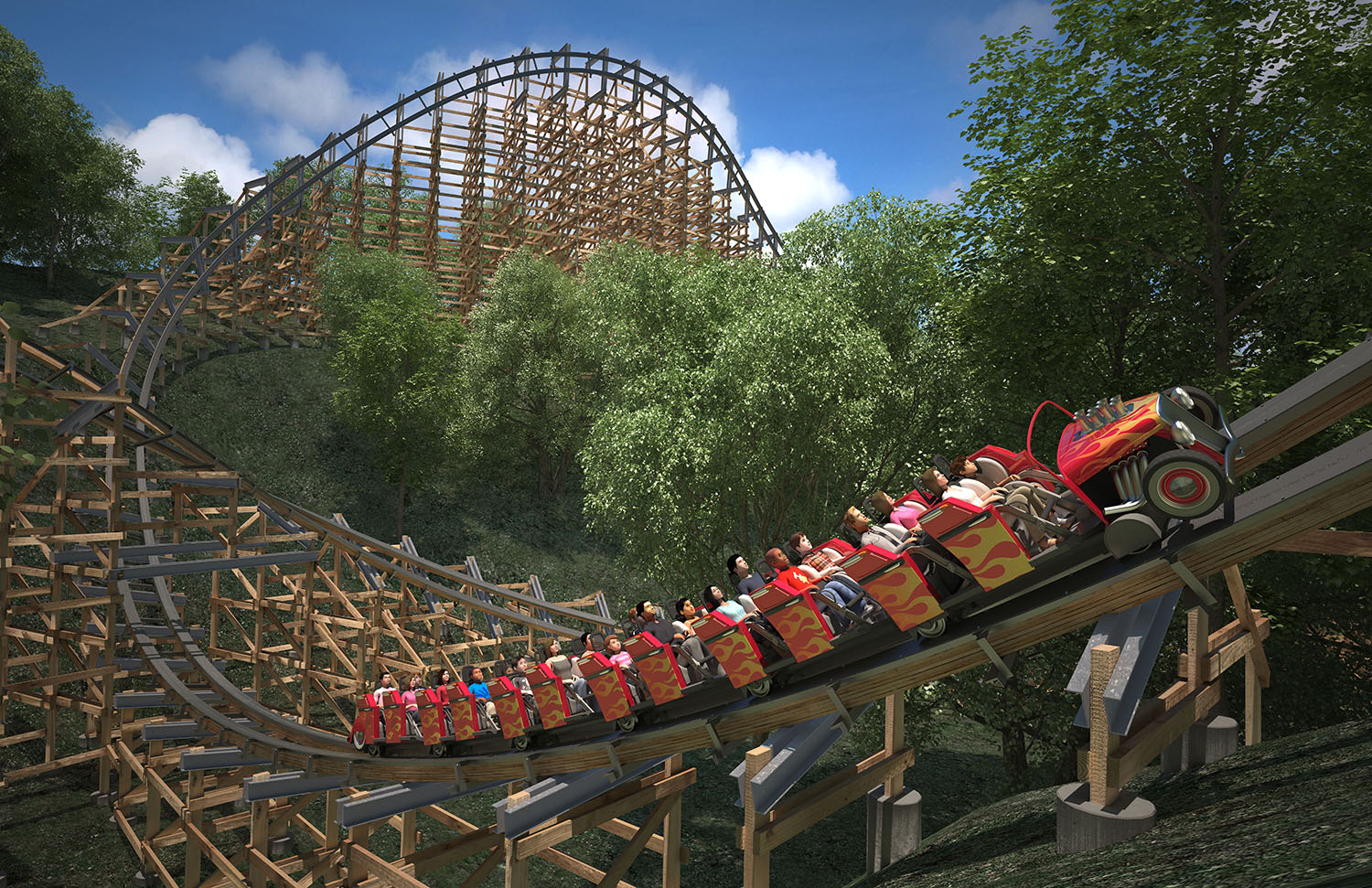
Modern wooden roller coasters unofficially date back to France the early 19th century when “Russian mountains” became sophisticated enough to see wheeled carts hoisted to the top of ramps and released along controlled dips. The oldest operating example of a wooden roller coaster today dates to 1902 in Altoona, Pennsylvania.
And since then, wooden coasters have largely been pretty easy to identify. Wooden roller coasters’ tracks are made of layered, laminated wood. By necessity, tracks have thin, flattened steel strips mounted on the wood as running rails - otherwise, the friction of train wheels would quickly deteriorate the wood. For the better part of 150 years, roller coasters were wooden - no qualifier needed.
Only with the opening of Disneyland’s Matterhorn Bobsleds in 1959 did the modern, tubular-tracked steel roller coaster appear, with three-wheel assembly (wheels above, below, and inside tubular track) later allowing delicacies like inversions.
And since then, that has been that. Like salt and pepper, fire and ice, and beginnings and endings, roller coasters have come in two - count ‘em, two - varieties. Sure, by the dawn of the New Millennium so-called “hybrid” coasters (steel lattice structure but wooden rails) dotted the landscape, but any coaster enthusiast would quickly insist it’s only the track itself that counts. Even as both steel and wooden coasters gained incredible launches, inversions, and elements, they were still inarguably either wood or steel. Period.

Then came Rocky Mountain Construction - RMC. In 2011, RMC renovated the notoriously rough Texas Giant at Six Flags Over Texas, tearing out its track, reshaping its structure, and installing its unique “I-Box” track (shaped like a serif-capital-I). RMC I-Box track became a panacea for parks plagued by big, audacious, and problematic wooden coasters. To date, 14 coasters at Six Flags, Cedar Fair, SeaWorld Parks, and beyond have gotten the treatment, all being reborn as headliners… but also, unquestionably, as steel.
But RMC’s innovation didn’t end there. In 2013, the company built its first coaster from scratch - Outlaw Run at Silver Dollar City - debuting a second track system: Topper Track. As its name implies, Topper Track essentially takes the basis of a wooden coaster - layered, laminated tracks with flattened steel running strips - and replaces the top two layers with a thicker “steel box.” If you buy that Topper Track merely upsizes the existing steel trip, then you’d agree with many who assert that despite being able to easily and comfortably tackle extreme overbanks, elaborate elements, and even inversions, “Topper Track” coasters are, by definition, wood.
So even though definitions aren’t quite as cut-and-dry as they used to be, most sources tend to agree: I-Box = steel; Topper Track = wood. And here’s where things get messy.
In 2016, Dollywood in Pigeon Forge, Tennessee debuted Lightning Rod - a from-scratch RMC coaster built with Topper Track. So although Lightning Rod was fast, steep, and extreme, if coasters with “Topper Track” are wood, then so was Lightning Rod. And since Lightning Rod also included a lift hill lined with LSM launch motors, that officially made Dollywood’s 2016 addition the world’s first launched wooden roller coaster. Yes, a launched, wooden coaster.
But wait. Lightning Rod was infamously plagued by downtime from its delayed opening. Visitors looked on in frustration as multi-month closures and testing became hallmarks of a visit to the park. It seems like more people had seen Lighting Rod closed than open, and brief bouts of operation often saw the ride close once more as on-site engineers reconfigured the track, the launch, and the trains one by one. Message boards and Twitter were alight with presumptions about what flaws RMC may be addressing from week to week, and what might happen to Lightning Rod in the long run. You might say that Lightning Rod had become a big, audacious, and problematic wooden coaster. So RMC handled it like they would any other.
Over the 2020-2021 offseason, Lightning Rod was the first RMC to be RMC’ed. It got the same treatment as Cedar Point’s Mean Streak, Six Flags Magic Mountain’s Colossus, or Busch Gardens’ Gwazi, and its problematic sections of (wooden) Topper Track were pulled and replaced with (steel) I-Box track.. A park spokesperson confirmed that 2,160 feet of the ride’s 3,800 length (about 57%) made the switch - including everything from the base of the ride’s launched first hill. With a keen eye, you can even see the Topper Track switch to I-Box at 0:15 in the video below, then see where the I-Box reverts back to Topper Track at :43.
If you – like many coaster enthusiasts – concede that Topper Track (even somewhat tenuously) “counts” as a wooden coaster, then Dollywood’s Lightning Rod will always be the first launched wooden roller coaster. However, is it still a launched wooden roller coaster? If 57% of the ride’s layout – including its signature element – has inarguably gone from toeing the wood-steel line to becoming what may truly be the first authentically hybrid roller coaster – roughly half-wood, half-steel.
As always, at the end of the day, it doesn’t really matter. Thanks to the precision of Topper Track, Lightning Rod didn’t necessarily feel like other wooden coasters anyway, so the replacement of its track is mostly an interesting footnote. But for those of us nerds who track our “coaster counts,” it’s a real predicament! If Lightning Rod changed from wood to steel in 2021, than does it count as a new coaster credit? More to the point, have you lost your chance to ride a launched, wooden coaster for good?





Add new comment